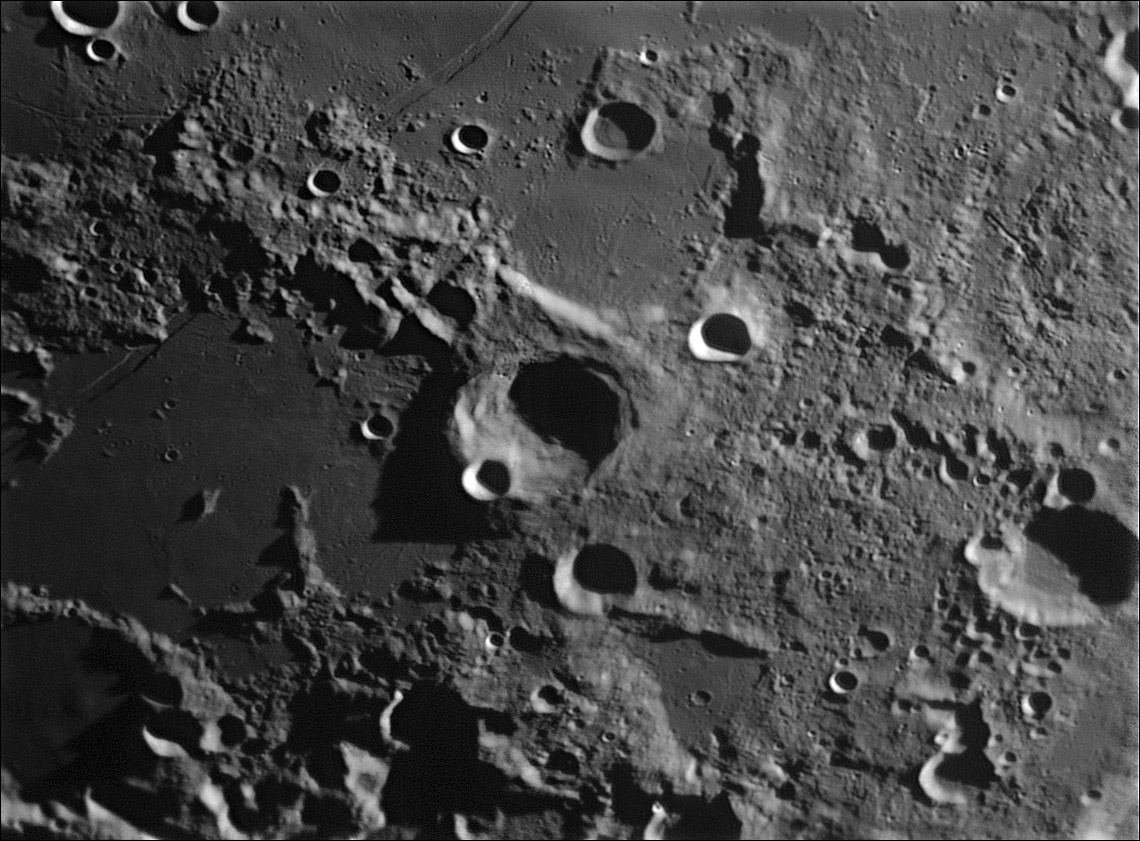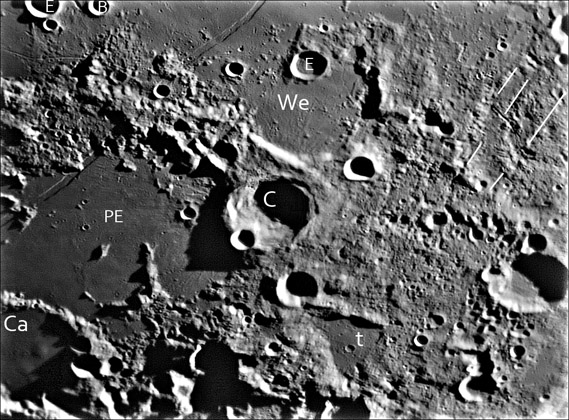Difference between revisions of "June 20, 2013"
| Line 10: | Line 10: | ||
<td><!-- ws:start:WikiTextLocalImageRule:15:<img src="/file/view/LPOD-Jun20-13b.jpg/438894434/LPOD-Jun20-13b.jpg" alt="" title="" /> -->[[File:LPOD-Jun20-13b.jpg|LPOD-Jun20-13b.jpg]]<!-- ws:end:WikiTextLocalImageRule:15 --><br /> | <td><!-- ws:start:WikiTextLocalImageRule:15:<img src="/file/view/LPOD-Jun20-13b.jpg/438894434/LPOD-Jun20-13b.jpg" alt="" title="" /> -->[[File:LPOD-Jun20-13b.jpg|LPOD-Jun20-13b.jpg]]<!-- ws:end:WikiTextLocalImageRule:15 --><br /> | ||
</td> | </td> | ||
| − | <td>Cichus is the 40 km wide crater in the middle of Stefan's excellent image, but it isn't the most interesting feature here. We can start at the top where the U-shaped Hesiodus Rille (a beautiful graben) cuts indiscriminately across mare and highlands. Also cutting both terrain types, but much more discretely, is a thin rille south of Kies E and B (top left) that extends almost to the Hesiodus Rille. The thin one is partly seen on the LRO QuickMap but the low Sun makes it more prominent here. The flat-floored crater Weiss is spattered with thick ejecta rays from Cichus, and narrower ejecta and bright rays cross Palus Epidemiarum to the west. Weiss E has been mentioned in earlier LPOD's as having an uncertain interior, and LRO [http://tinyurl.com/klay7mf images] now reveal it to be a small floor-fractured crater. Just southeast of E on the eastern floor of Weiss are two or three delicate [http://lpod. | + | <td>Cichus is the 40 km wide crater in the middle of Stefan's excellent image, but it isn't the most interesting feature here. We can start at the top where the U-shaped Hesiodus Rille (a beautiful graben) cuts indiscriminately across mare and highlands. Also cutting both terrain types, but much more discretely, is a thin rille south of Kies E and B (top left) that extends almost to the Hesiodus Rille. The thin one is partly seen on the LRO QuickMap but the low Sun makes it more prominent here. The flat-floored crater Weiss is spattered with thick ejecta rays from Cichus, and narrower ejecta and bright rays cross Palus Epidemiarum to the west. Weiss E has been mentioned in earlier LPOD's as having an uncertain interior, and LRO [http://tinyurl.com/klay7mf images] now reveal it to be a small floor-fractured crater. Just southeast of E on the eastern floor of Weiss are two or three delicate [http://www2.lpod.org/wiki/May_2,_2009 rilles] whose tectonic reasons for existence are unknown. Further east I've drawn some short white lines called lineaments. This word is used when linear features are seen but their reality and origin are uncertain. South of Cichus is an odd [http://www2.lpod.org/wiki/February_18,_2012 t-shaped depression] with a dark floor. This depression may be a basin secondary crater but it is not certain if the smoothish dark material filling it is mare lava. Finally, moving into the shadows at bottom left are two small mounds that are the well known, but rarely seen Capuanus domes.<br /> |
</td> | </td> | ||
</tr> | </tr> | ||
| Line 23: | Line 23: | ||
<strong>Related Links</strong><br /> | <strong>Related Links</strong><br /> | ||
Rükl plate [https://the-moon.us/wiki/R%C3%BCkl_63 63]<br /> | Rükl plate [https://the-moon.us/wiki/R%C3%BCkl_63 63]<br /> | ||
| − | <em>[ | + | <em>[[21st Century Atlas of the Moon|21st Century Atlas]]</em> chart 16.<br /> |
<br /> | <br /> | ||
<p><b>Yesterday's LPOD:</b> [[June 19, 2013|Still Fighting Old Wars]] </p> | <p><b>Yesterday's LPOD:</b> [[June 19, 2013|Still Fighting Old Wars]] </p> | ||
Latest revision as of 07:30, 28 October 2018
Rilles, Domes And Ejecta

image by Stefan Buda, Australia
 |
Cichus is the 40 km wide crater in the middle of Stefan's excellent image, but it isn't the most interesting feature here. We can start at the top where the U-shaped Hesiodus Rille (a beautiful graben) cuts indiscriminately across mare and highlands. Also cutting both terrain types, but much more discretely, is a thin rille south of Kies E and B (top left) that extends almost to the Hesiodus Rille. The thin one is partly seen on the LRO QuickMap but the low Sun makes it more prominent here. The flat-floored crater Weiss is spattered with thick ejecta rays from Cichus, and narrower ejecta and bright rays cross Palus Epidemiarum to the west. Weiss E has been mentioned in earlier LPOD's as having an uncertain interior, and LRO images now reveal it to be a small floor-fractured crater. Just southeast of E on the eastern floor of Weiss are two or three delicate rilles whose tectonic reasons for existence are unknown. Further east I've drawn some short white lines called lineaments. This word is used when linear features are seen but their reality and origin are uncertain. South of Cichus is an odd t-shaped depression with a dark floor. This depression may be a basin secondary crater but it is not certain if the smoothish dark material filling it is mare lava. Finally, moving into the shadows at bottom left are two small mounds that are the well known, but rarely seen Capuanus domes. |
Chuck Wood
June 20th is the 150th anniversary of statehood for West Virginia, the only state that successfully seceded from another. And June 20th is also the 8th anniversary of when I arrived in West Virginia; I am sure that is what all the celebrations are about.
Technical Details
18 June 2013, 405mm Dall-Kirkham telescope and DMK21AU04 camera, through red filter.
Related Links
Rükl plate 63
21st Century Atlas chart 16.
Yesterday's LPOD: Still Fighting Old Wars
Tomorrow's LPOD: Harbinger Highlights
COMMENTS?
Register, Log in, and join in the comments.



